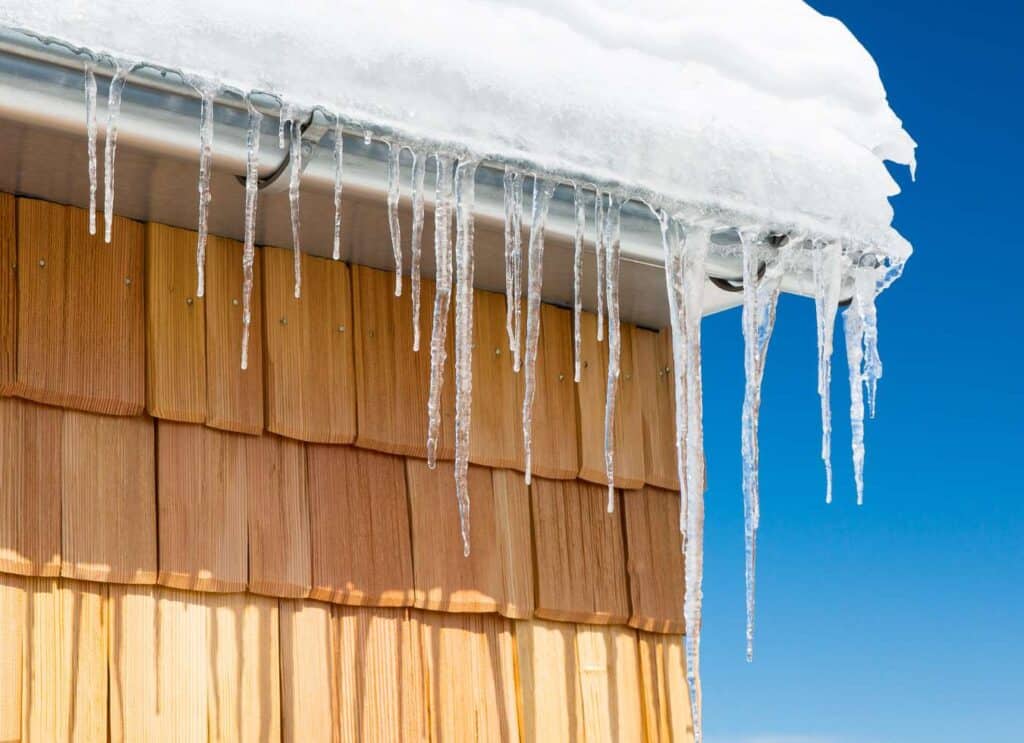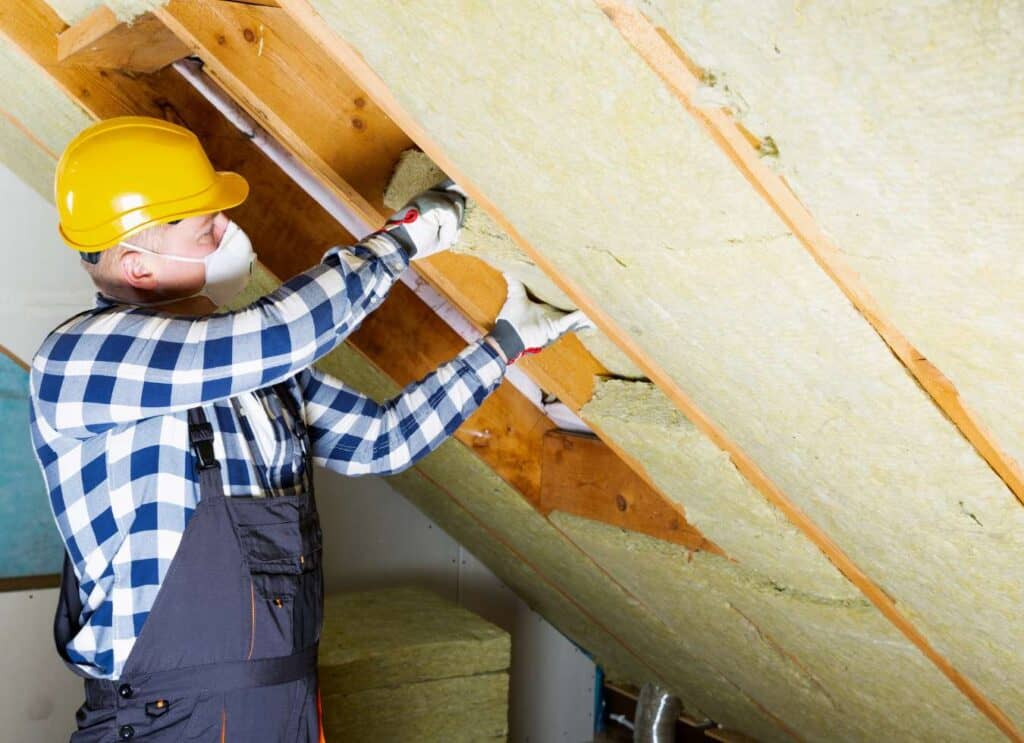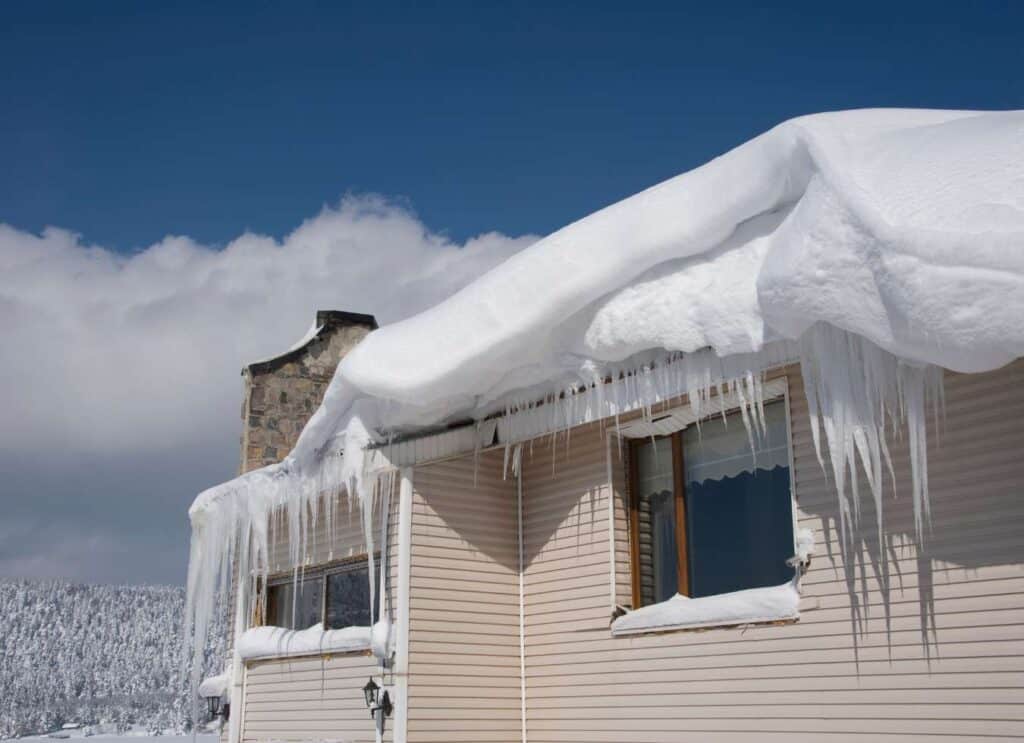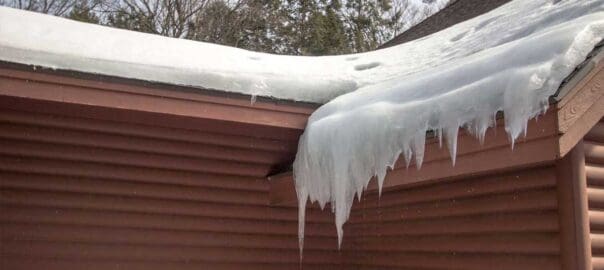As winter sets in here on the Colorado Front Range, it’s time to start thinking about more than snow boots and hot chocolate (though those are important, too).
If you’re a homeowner, winter means your roof will face some of the most challenging conditions of the year. Your roof has much to handle, from heavy snow to freezing temperatures. And when winter weather gets especially wild, ice dams are the perfect recipe for a roofing nightmare.
So, what exactly is an ice dam? And more importantly, what can you do to prevent one? Because let’s be honest—nobody wants to deal with leaks, water damage, and the headache that comes with a winter roof disaster.
This guide will explain everything you need to know about ice dams, why they form, and how to protect your roof this winter. Get ready to be the most informed homeowner in your neighborhood—and maybe even impress your friends with your roofing knowledge. Let’s dive in!

What Is an Ice Dam, and Why Should You Care?
You’ve probably heard the term “ice dam” tossed around like a bad word, especially if you live in Colorado during heavy snowfall. But what exactly is it, and why should it make you break into a cold sweat?
An ice dam is precisely what it sounds like: a large chunk of ice that forms along the edge of your roof, preventing snowmelt from draining into your gutters. And here’s where the trouble starts. Instead of flowing into the gutters and off your roof, the melted snow gets trapped and refreezes, creating an ice barrier.
But that’s not the worst part. As the snow melts, the water backs up under the shingles and seeps into your attic or walls. This leads to all kinds of damage—water stains, rotting wood, mold, and even structural issues if left unchecked. So, when you see the word “ice dam,” it’s pretty much synonymous with a roofing nightmare.
Ice dams aren’t just some abstract problem that happens to “other people.” If you live on the Colorado Front Range, where snow and freeze-thaw cycles are a regular part of life, ice dams can happen to anyone. But don’t panic; with proper preparation, you can mitigate the risks of ice dam formation. The good news is that you can avoid this headache with proactive care and keep your roof safe.
Why Do Ice Dams Form in the First Place?
Okay, before we discuss prevention strategies, let’s examine how ice dams form. It all starts with snow, but the combination of heat and cold creates the perfect storm (pun intended!).
Here’s the basic sequence of events:
- Snow accumulates on your roof. When a snowstorm rolls in, the usual blanket of white covers your roof. The snow will stay there if the temperature is cold enough, increasing over time.
- Your attic stays warm, which is essential for effectively managing snowmelt. If it isn’t adequately insulated, the heat from your home will leak into the attic space, warming the underside of your roof. This causes the snow at the top of the roof to melt.
- Water flows down. The melting snow turns into water and flows down the roof’s slope toward the eaves (the roof’s edges). But here’s the twist: while the water flows toward the edge, the air around the eaves is much colder.
- Water freezes as it reaches the cold edge of the roof, forming ice. Over time, the ice builds up, blocking the flow of any additional melting snow.
- Backed-up water causes leaks. Now that you have a nice block of ice along the edge of your roof, the melted snow has nowhere to go. It backs up under the shingles and can leak into your attic or home, causing all sorts of damage.
This is the dreaded ice dam in action. In Colorado, with our freezing temperatures, snow, and high-altitude sun (which makes the temperature fluctuate dramatically), ice dams are something every homeowner should consider as winter approaches.

How to Prevent Ice Dams on Your Roof
The good news is that prevention is possible! Yes, you can take steps to keep ice dams from forming, so you don’t have to worry about roof leaks and costly repairs. Let’s get into the steps you can take to protect your roof, home, and peace of mind this winter against harsh weather patterns.
1. Insulate Your Attic Like a Pro
Think of your attic as the control center for your roof’s performance in winter. If the attic gets too warm, it’s like sending a “green light” for ice dams to form. That’s why good drainage is vital for maintaining the integrity of your roofing material. Attic insulation is your first line of defense.
Proper insulation keeps the heat inside your home where it belongs and prevents it from leaking into the attic. Foam insulation and fiberglass batt insulation are great options, but whatever you choose, make sure your attic is fully insulated.
Here’s what to aim for:
- Insulation: Aim for at least R-38 to R-60 insulation in your attic. This ensures the heat stays where it should, preventing snow on the roof from melting too soon and refreezing at the edges.
- Seal leaks: Go around your attic and seal any air leaks where warm air could escape. You’d be surprised how much heat can escape through small gaps in the walls, vents, or around ducts.
2. Ventilate Your Attic
Ventilation is key to keeping your attic cool and is one of the best ways to prevent ice dams from forming. Proper attic ventilation ensures that your attic remains at the same temperature as the outside air, which helps avoid that melting-and-freezing cycle.
Here’s how to improve ventilation:
- Install soffit vents: These vents allow cool air to enter the attic from the eaves. It’s like giving your attic a breath of fresh air!
- Add ridge vents and/or deck venting: Ridge vents are installed at the roof’s peak and allow warm air to escape, so ventilation is key in your roofing system. This creates an airflow system that keeps the attic cold and dry, helping to prevent ice dam formation. Deck Vents are used when your soffit vents are not working as they should, are covered in insulation, and are hard to get to, or you are looking for a ventilation upgrade.
- Use a balanced ventilation system: The ideal setup involves intake and exhaust vents to ensure proper airflow throughout the attic. This helps prevent ice dams by keeping the attic at a consistent temperature.
3. Clean Your Gutters Regularly
This one’s simple, but it’s easy to forget—clean your gutters! Water can’t flow properly if your gutters contain leaves, twigs, or dirt. When snow begins to melt, the water gets trapped in the clogged gutters, which can freeze and form ice dams.
Schedule a roof inspection, clean your gutters in the fall before the snow flies, and check them periodically during the winter weather. Installing gutter guards is another excellent way to keep debris out and reduce the chances of clogs.
4. Consider Heat Cables for Extra Protection
Heat cables can be a game-changer for some homes, especially those with a lot of snow and ice buildup yearly. These electric cables run along the roofline and gutters to prevent ice from forming.
Heat cables warm the roof and gutters, keeping the melting snow flowing freely instead of refreezing into an ice dam. It’s like giving your roof a heated blanket!
While heat cables aren’t for every home, they can be an excellent investment for those in snow-heavy areas or those who’ve had recurring issues with ice dams.
5. Call a Professional Roofer for an Inspection
If you’re unsure where to start or whether your home’s insulation and ventilation are up to snuff, don’t hesitate to call a professional roofer. At Denny’s Roofing, we specialize in helping homeowners on the Colorado Front Range prepare for winter and prevent ice dams from causing damage.
A roofer can inspect your attic, check your roofline, and help ensure your home is ready to face the snow. Sometimes, a little tweak here and there can make a huge difference in preventing future ice dam issues.

Other Popular Questions Related to Roofing System
Q: What is an ice dam, and how does it form on roofs in Colorado’s unique climate?
A: An ice dam is a ridge of ice forming at the roof’s edge, preventing melting snow from draining off. In Colorado’s unique climate, with its heavy snowfall and fluctuating temperatures, ice dam formation occurs when snow melts on the warmer parts of the roof and refreezes at the colder edges, leading to potential water damage.
Q: How can proper ventilation and insulation help prevent ice dams?
A: Proper ventilation and insulation are crucial for ice dam prevention. They help maintain a consistent indoor temperature and prevent warm air from escaping to the roof, which can cause snow to melt and refreeze. Ensuring your attic is well-ventilated and insulated can significantly reduce the risk of ice dams.
Q: Why is regular roof inspection necessary for homeowners in Colorado?
A: Due to Colorado’s challenging climate, regular roof inspection is vital for homeowners. A professional inspection can identify potential issues with your roofing system, ensuring that it can withstand heavy snowfall and prevent ice dam formation, thus protecting the integrity of your home.
Q: What role does a roofing contractor play in preparing for winter weather?
A: A roofing contractor can help prepare your roof for winter weather by assessing its condition, recommending necessary repairs, and ensuring proper insulation and ventilation. This proactive approach extends your roof’s lifespan and prevents problems in Colorado’s harsh winter months.
Q: How does snow removal help in preventing ice dams?
A: Snow removal is essential in preventing ice dams, especially in Colorado’s unique climate. Using a roof rake to remove snow accumulation from the roof can prevent excessive snow melting and refreezing, reducing the risk of ice dam formation and subsequent water damage.
Q: What are the best practices for maintaining your roof’s drainage system during winter?
A: Maintaining your roof’s drainage system during winter ensures that gutters and downspouts are clear of debris and ice. This allows for proper snowmelt drainage, preventing water buildup and potential ice dam formation, which can compromise the roofing material and the integrity of your home.
Q: How can homeowners extend their roof’s lifespan in Colorado’s challenging climate?
A: Homeowners can extend their roof’s lifespan by conducting regular maintenance, ensuring proper insulation and ventilation, and addressing any issues promptly with the help of a roofing company. Adapting to Colorado’s challenging climate by preparing for its unique weather patterns is key to preserving your roofing system.
Q: What should be considered when planning a roofing project in Colorado?
A: When planning a roofing project in Colorado, consider the unique climate and choose suitable roofing materials that can withstand heavy snowfall and fluctuating temperatures. Consulting with roofing experts can ensure that the project addresses specific needs for ice dam prevention and extends the roof’s lifespan.
Q: How can drainage issues impact the integrity of your home during winter?
A: Poor drainage can lead to water buildup and ice dam formation, which can cause significant water damage to your home. Ensuring a functional drainage system, especially during heavy snowfall, is crucial for maintaining the integrity of your home and preventing costly repairs.
Q: What is ice dam formation, and how does it affect homeowners in Colorado?
A: Ice dam formation occurs when snow on the roof melts and refreezes at the eaves, creating a barrier that prevents proper drainage. This can lead to water damage inside the home, especially in Colorado’s unique climate, where winter weather can be severe.
Q: How can proper insulation help prevent ice dams?
A: Proper insulation prevents warm air from escaping into the attic, reducing the likelihood of snow melting on the roof. This is crucial for ice dam prevention as maintaining a consistent roof temperature minimizes the risk of ice dam formation.
Q: Why is ventilation important for preventing ice dams?
A: Ventilation helps regulate the indoor temperature and prevent heat from accumulating in the attic. This reduces snowmelt on the roof, which is essential for preventing ice dams and extending your roof’s lifespan.
Q: What role does a roofing contractor play in preparing for winter?
A: A roofing contractor can perform a roof inspection to identify potential issues and recommend solutions tailored to Colorado’s challenging climate. This may include ensuring proper insulation and ventilation to prevent ice dams and protect the integrity of your home.
Q: How does Colorado’s unique climate present challenges for roofing projects?
A: Colorado’s unique climate presents challenges like heavy snowfall and fluctuating temperatures. These conditions can lead to ice dam formation and water damage, making it crucial to choose the right roofing material and ensure proper drainage.
Q: What are some effective snow removal strategies for homeowners?
A: Homeowners can safely remove snow accumulation from the roof using a roof rake, which helps prevent ice dams. It’s important to remove snow regularly, especially after heavy snowfall, to maintain the integrity of your home.
Q: Why is regular maintenance necessary for extending your roof’s lifespan?
A: Regular maintenance, including professional inspections and promptly addressing minor issues, can prevent significant problems like ice dam formation. This is particularly important in Colorado winters, where weather conditions can be harsh.
Q: How does heavy snow accumulation impact the roofing system?
A: Heavy snow accumulation can increase the load on the roofing system, leading to potential structural damage. It also contributes to ice dam formation, making adequate drainage and snow removal crucial for protecting your roof.
Q: What should homeowners consider when selecting a roofing company for ice dam prevention?
A: Homeowners should look for a roofing company experienced with Colorado’s unique climate. They should ensure the company offers solutions for proper insulation, ventilation, and drainage to prevent ice dams effectively.

Conclusion: Protecting Your Roof from Ice Dams This Winter
Winter in Colorado can be harsh on your roofing system, but with the proper preparation, you can prevent ice dam formation and protect your home from the dangers of water damage. These simple steps, from insulating your attic to ensuring adequate ventilation and cleaning your gutters, can go a long way in preventing ice dam formation.
If you’re unsure where to start or want a professional opinion on preparing your roof for winter, Denny’s Roofing, your local roofing contractor, is here to help. We understand Colorado homeowners’ unique challenges and are ready to give you the tools and knowledge to keep your roof in top condition all season.
Stay warm, stay safe, and keep your roof ice-dam-free!

